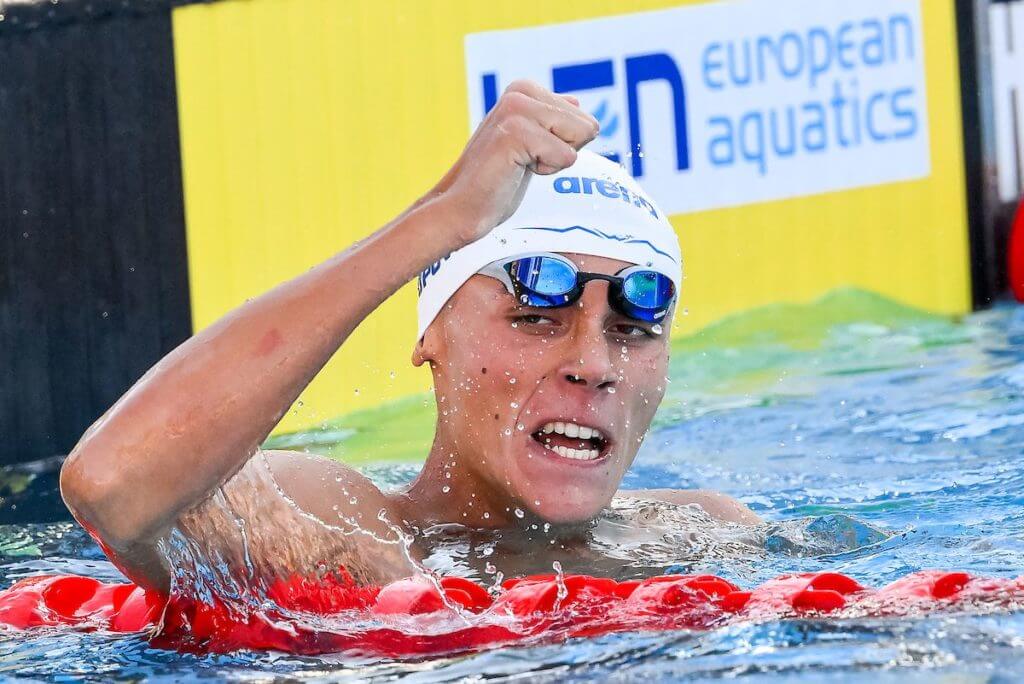The Difference Between David Popovici and Other Sprint Greats? It’s In The Back Half

The Difference Between David Popovici and Other Sprint Greats? All On Back Half
Over the summer, Romanian teenager David Popovici broke a record so many sprint greats fell just short of. Cesar Cielo was the standard-bearer in the 100 freestyle for 13 years, and in the period of time after polyurethane suits were banned at the end of 2009, five swimmers came within two tenths of Cielo’s record but could never get over the top.
The list of swimmers who came oh-so-close included Caeleb Dressel, the American who won world titles in the 100 free in 2017 and 2019 before winning gold in an exceptionally tight Olympic final last year, along with Australians Cameron McEvoy, Kyle Chalmers and James Magnussen and Russia’s Kliment Kolesnikov. When Cielo swam the 46.91, he was out in 22.17 and back in 24.74. Matching the Brazilian’s early speed has proven to be nearly impossible for anyone else in the world, so here’s how the challengers performed in the many close calls.
- At Australia’s Olympic Trials in 2012, Magnussen swam a time of 47.10 by going out in 22.68 and returning in 24.42. At that point, Magnussen was already the world champion in the event, but after that one race, he seemed destined to be the one to top Cielo. However, Magnussen would end up with a silver medal at the ensuing London Olympics (one hundredth behind American Nathan Adrian), and he never came close to 47-low form again.
- Four years later, McEvoy split 22.54/24.50 on his way to a time of 47.04. He lowered the Australian record previously held by Eamon Sullivan (47.05, which had been the world record prior to Cielo). But he faltered on the Olympic stage as his fellow Aussie in the event, a 17-year-old Chalmers, stormed through the field to win Olympic gold.
- The closest attempt at the world record occurred in 2019, when Dressel held off Chalmers for a world title by just 0.12. Dressel split 22.29/24.67 for a final mark of 46.96, making him the third member of the sub-47 club (along with Cielo and Alain Bernard) and the first in a textile suit, while Chalmers went 22.79/24.29 for a 47.08.
- At the delayed Tokyo Olympics, Kolesnikov dropped the hammer in the semifinals with a 47.11, splitting 22.52/24.59. One day later, Dressel again held off Chalmers for gold by an even-narrower margin of 47.02 to 47.08. The American split his race 22.39/24.63, while Chalmers was 22.71/24.37.
To recap, each of these record attempts involved a swimmer going out behind world-record pace and then closing much quicker than Cielo did in 2009. The fastest of these closing splits was the 24.29 that Chalmers swam in 2019.
But when Popovici finally got those last few hundredths that this cadre of sprint stars never could, he covered the first 50 meters slower than any of them. In his historic swim at the European Championships, Popovici was out in 22.74 before closing in 24.12 to hit the wall in 46.86 and a new world record. One day earlier in the semifinal, Popovici had split 22.93 on the way out and then 24.05 coming back as he swam under 47 for the first time. Those two finishing splits were the quickest in history, surpassing even the 24.20 that Michael Phelps swam in his 400 free relay leadoff leg at the 2008 Olympics.
It makes sense that Popovici, who specializes in the 100 and 200 free, would finish faster than Cielo and the men who challenged his record, most of whom specialize in the 50 and 100 free. Still, it’s jarring to think that a man could employ a relatively routine pace on the initial split and still come home quick enough to record history’s fastest time.
From 2009 until August 2022, there was almost never a 100 free final where swimmers flipped under world-record pace at the halfway point. Now? Expect to see the superimposed world-record line pop up with regularity at international competitions and even national-level meets, but one the second lap, Popovici’s finishing pace will prove way too much for his peers to handle.
Moving forward, there would be two ways for Popovici to improve upon his own standard. The more likely outcome is he adds power as he concludes his teenage years and moves into his 20s, and that allows him to get out quicker while maintaining his lights-out back end. The other option would involve finishing with a 23-second split, nearly unfathomable territory that never would have been considered possible prior to Popovici’s rewriting of the record books this year.




Rest….rest…and more rest will bring about a faster second half 50…power???…it’s called rest!…if these kids are encouraged to force the first half and then pray for a fast second half they are delusional! I know I will be criticized…however, it remains clear (in swimming and in running) that an athlete will most likely improve their overall performance with realistic negative splitting…
Think Janet Evans!